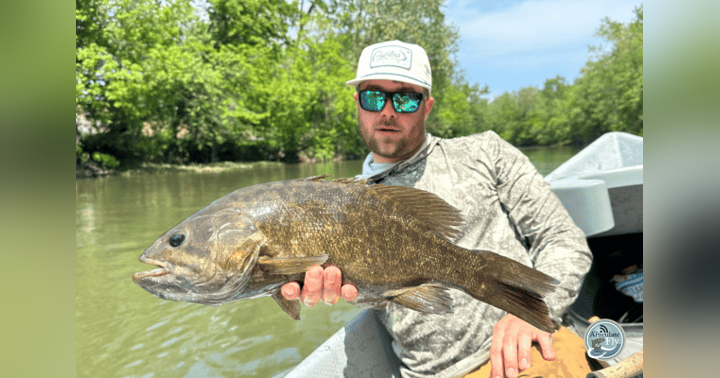HOW A TROUT SEES: THE RULE OF SIX AND OTHER THINGS

In order to effectively stalk trout, you need to fundamentally understand how a trout sees. First of all, unlike you and me, trout have lateral lines that run down each side of their bodies. These lateral lines allow trout to feel vibrations in the water. For instance, trout hear you when you thud down a bank on your way to the water or when you noisily wade in a stream. (As a footnote, these sound vibrations travel better (are louder) in water than in air, because water is a better conductor.) Take to heart the advice to fish like a heron, and you will put more fish in the net. However, take it from the Beach Boys, not all vibrations are bad. In addition to their eyesight, trout use vibration to locate food. You can use this to your advantage. For instance, if water visibility is poor, consider using a fly with a rattle. Or, use a fly with a large head that will push water and create vibrations as you strip it through the water.
A trout’s vision is radically different from ours. First, they don’t have eyelids, so it shouldn’t surprise you that they will seek shadier water during periods of intense sunlight. Second, a trout’s eyes are set on the side, and not the front, of its head. As a result, trout have a much wider field of vision than we do with a small blind spot immediately behind them. (As an aside, this is a common adaptation of species that are traditionally prey items. The wider field of vision allows the prey to more easily see potential predators.) From a tactical perspective, this explains the preference for an upstream presentation instead of a downstream one.
However, the most interesting element of a trout’s vision is a function of seeing through water. Remember when you were a kid swimming underwater in a swimming pool? If you were deep enough, you should remember that most of the water’s surface was silver and reflective, and you could clearly see a circular area above your head. This is very similar to what a trout sees everyday.
A trout’s overhead field of vision is circular. Objects in the center of the circle appear to be normally sized while objects on the circle’s periphery appear compressed. The water actually bends the light allowing the trout to see items well outside of the circle immediately above its head. Think of a funnel concentrating a much larger visual area into a small circle. For instance, a six foot tall fisherman far away from a trout will appear significantly smaller so much so, in fact, that the trout may only recognize the fisherman’s movement and not be able to differentiate him from the surroundings. More on this later. It is super cool. I promise. Similarly, as a dry fly floats downstream towards a trout, its size grows from small and compressed on the edge of the circle to normally sized as it floats over the trout. Think off a ship coming over the horizon and appearing to grow out of the water’s surface due to the Earth’s curvature. Finally, the diameter of the trout’s circular field of vision is a function of water depth. A trout holding in shallow water will have a smaller circular field of vision than a trout holding in deeper water. The rough rule of thumb is the diameter of the circle is approximately 2.25 times the trout’s depth, so a trout holding in a foot of water has an overhead circle of vision of approximately 2.25 feet. If your dry fly is outside of the circle, it is invisible. (As an aside, Snell’s Law explains refraction and the effect of water and water depth on a trout’s vision. If you want to geek out, check out Wikipedia.)
Remember the funnel I mentioned in the previous paragraph? If you stay underneath the funnel’s bottom edge, you are effectively invisible to the trout. Without digging into the geometry, you are underneath the trout’s field of vision when you follow the Rule of Six. For each foot of elevation above the water’s surface, you need to be at least six feet away from the edge of the trout’s field of vision.
The Example:
The trout is holding in two feet of water. You are six feet tall standing in two feet of water. (Let’s assume you are casting sidearm and the rod tip stays below your head. That way, we don’t have to adjust for the vertical distance between the top of your head and the rod tip.) You need to be at least 26.25 feet away from the trout to be below its field of vision.
The Math:
Distance from the trout is half the diameter of its overhead field of vision ((2*2.25)/2) or 2.25 feet. Remember the trout is in the middle of the circle.
Distance from the edge of the trout’s field of vision is 6 times the height above the water or 6*(6 (Angler Height) minus 2 (Wading Depth)) or 24 feet.
2.25 feet + 24 feet =26.25 feet.
What if you knelt and decreased your net height to three feet? You would only need to be at least 20.25 (2.25+(6*3)) feet away from the trout. Now, you understand why keeping a low profile can be so effective! The Rule of Six can really help tip the fishing odds in your favor.
At The Articulate Fly, we love questions! Please post a comment or send us your question.
Follow us on Facebook, Instagram, LinkedIn, Twitter or YouTube.




